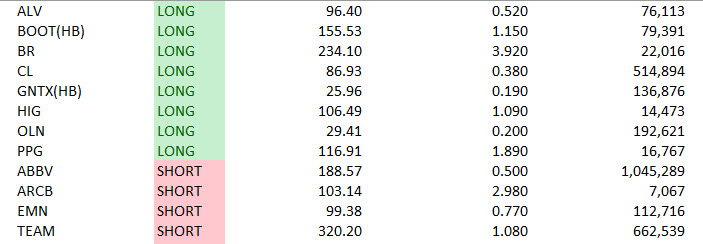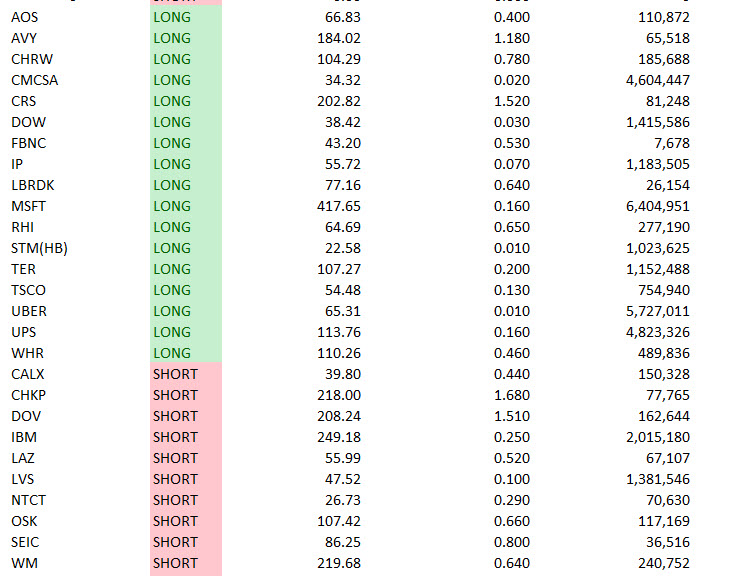The Small Cap Swing Trader Alert Archive
Below you'll find The Small Cap Swing Trader setups stacked up and ordered chronologically.Trump Canada-Mexico Tariffs
Trump’s Canada-Mexico Tariffs: What Traders Need to Know
On January 31, 2025, Reuters reported that former President Donald Trump is set to announce new tariffs on imports from Canada and Mexico, effective March 1. These Trump Canada-Mexico tariffs could have significant ramifications across various sectors of the stock market. Here’s what traders should watch for:
Trump Canada-Mexico Tariffs Sector Analysis
Automotive Sector: Facing a Major Hit
The North American auto industry is deeply integrated, with parts and vehicles crossing borders multiple times before final assembly. A 25% tariff on imports from Canada and Mexico could significantly impact automakers such as General Motors (GM), Ford (F), and Tesla (TSLA), as well as parts manufacturers like Magna International (MGA) and BorgWarner (BWA). Higher costs could lead to reduced profit margins, potential price hikes, and lower demand, causing volatility in these stocks. Trump Canada-Mexico tariffs will be a major factor in shaping the automotive sector’s outlook.
Energy Sector: Crude Oil Uncertainty
Canada is the largest supplier of crude oil to the United States. The uncertainty around whether Canadian and Mexican oil will be subject to tariffs could drive volatility in energy stocks, particularly in companies like ExxonMobil (XOM), Chevron (CVX), and Canadian firms such as Suncor Energy (SU). If Trump Canada-Mexico tariffs include crude imports, expect higher gasoline prices and potential profit squeezes for refiners like Valero (VLO) and Marathon Petroleum (MPC).
Agriculture: Higher Food Prices and Retaliatory Risks
The U.S. imports a significant portion of its fruits, vegetables, and other agricultural products from Mexico and Canada. Companies like Fresh Del Monte (FDP) and Bunge (BG) could see cost increases that might be passed on to consumers. Additionally, if Mexico retaliates with tariffs on U.S. farm goods, agricultural giants such as Archer Daniels Midland (ADM) and Deere & Co. (DE) could experience price swings and revenue uncertainty. Trump Canada-Mexico tariffs will be a key concern for traders in this sector.
Retail and Consumer Goods: Rising Costs, Falling Margins
Retailers and consumer goods companies that rely on North American supply chains—such as Walmart (WMT), Target (TGT), and Costco (COST)—may face cost pressures. Higher prices on imported goods like electronics, beer, and clothing from Mexico could lead to lower consumer spending, squeezing margins for companies dependent on price-sensitive shoppers. The Trump Canada-Mexico tariffs could significantly alter pricing strategies and consumer behavior.
Construction and Materials: Tariffs on Lumber and Aluminum
The construction industry relies heavily on Canadian lumber and aluminum. Companies like Weyerhaeuser (WY) and West Fraser Timber (WFG) could see rising costs. Higher aluminum prices would also impact firms like Alcoa (AA) and Century Aluminum (CENX), while homebuilders such as D.R. Horton (DHI) and Lennar (LEN) might struggle with increasing material costs. These Trump Canada-Mexico tariffs could disrupt supply chains and construction pricing models.
Technology: Electronics Supply Chain at Risk
Many electronics manufacturers and suppliers import components from Mexico. Companies such as Apple (AAPL) and Qualcomm (QCOM) could face supply chain disruptions or increased costs. Meanwhile, firms like Foxconn (HNHPF), which has operations in Mexico, may need to rethink logistics to mitigate the impact. The Trump Canada-Mexico tariffs could force tech firms to find alternative sourcing strategies.
Trump Canada-Mexico Tariffs – Broader Markets
Market Reactions and Trading Strategies
The looming tariffs could inject volatility into the markets, creating opportunities for traders who are prepared. Here are a few potential strategies:
- Shorting vulnerable sectors: Auto manufacturers, retailers, and agriculture stocks could see near-term downside pressure.
- Opportunistic long positions: Energy and certain industrial stocks may benefit from supply chain shifts and pricing adjustments.
- Watching retaliatory tariffs: If Canada and Mexico impose countermeasures, specific U.S. industries could experience heightened risks.
- Monitoring exemptions: If exemptions are granted, some stocks may recover quickly, creating reversal trading opportunities.
Final Thoughts
Trump Canada-Mexico tariffs could have sweeping implications for the North American economy. While the final details remain uncertain, traders should prepare for increased volatility and sector-specific impacts. As always, staying ahead of the news and adapting trading strategies accordingly will be crucial in navigating these market changes.
For real-time analysis and trade insights, join us in the War Room as we track how these developments unfold and impact market movements.
Good Trading,
Adrian Manz
For updates see Trump will implement tariffs on Mexico, Canada and China on Saturday | Reuters
Related articles at Traderinsight.com:
January 31, 2025

Apple Earnings Report: The Key Metric Traders Are Watching Today
AAPL Earnings Report – Here’s What to Watch For
As Apple prepares to release its latest earnings report after the bell today, traders and investors are zeroing in on one critical figure: Apple earnings report iPhone sales in China. With Apple’s stock facing increased scrutiny amid rising competition, the company’s performance in this key market could determine its near-term trajectory.
The iPhone Revenue Factor
Apple’s iPhone segment remains its primary revenue driver, and analysts project a modest 2% year-over-year increase in iPhone sales, reaching approximately $70.72 billion. However, concerns loom over the company’s declining smartphone shipments in China, where domestic brands such as Huawei and Vivo have aggressively expanded their market share. Given that China accounts for a substantial portion of Apple’s global revenue, a weaker-than-expected performance in this region could send bearish signals to the market. The Apple earnings report iPhone sales will be closely watched to gauge the company’s strength in the competitive smartphone market.
Challenges in China
One of the major hurdles Apple faces in China is regulatory restrictions on its Apple Intelligence features. Unlike in other markets, iPhones sold in China do not come equipped with these AI-powered enhancements, putting Apple at a potential disadvantage against local competitors. Additionally, increased consumer preference for domestic brands and broader economic headwinds in the region add to the challenges Apple must navigate. Analysts expect the Apple earnings report iPhone sales to highlight these competitive pressures.
Revenue and EPS Expectations
Wall Street expects Apple to report total fiscal first-quarter revenue of $124.38 billion, marking a 4% year-over-year increase. Meanwhile, earnings per share (EPS) are anticipated to rise to $2.35, reflecting continued profitability despite global economic uncertainty. While these headline numbers will be crucial, the market’s reaction will likely hinge on Apple’s forward guidance and management’s commentary on key growth drivers, including Apple earnings report iPhone sales trends.
What This Means for Traders
For traders, today’s earnings report presents an important inflection point. A strong beat on Apple earnings report iPhone sales—especially in China—could fuel a bullish rally, while disappointing numbers may pressure the stock downward. Additionally, guidance on services revenue, Mac and iPad sales, and Apple’s strategy in artificial intelligence will be closely analyzed for long-term growth prospects.
Final Thoughts
As earnings approach, traders should be prepared for potential volatility. Whether Apple’s report signals strength or weakness, the reaction in after-hours trading could set the tone for broader tech sector performance in the coming weeks. Keep a close watch on Apple earnings report iPhone sales figures and any insights provided on Apple’s China strategy, as these factors could significantly impact the stock’s direction.
Stay tuned to TraderInsight for a full breakdown of Apple’s earnings results and their implications for the market.
Good Trading,
Adrian Manz
Related Article Apple (AAPL) Q1 earnings 2025
January 30, 2025

DeepSeek and Its Disruption of the AI Industry and Stock Market
DeepSeek AI Disruption
The artificial intelligence landscape is undergoing a seismic shift with the introduction of DeepSeek-R1, a breakthrough AI model from China’s DeepSeek. This innovation is poised to disrupt the AI ecosystem and trigger profound ramifications in technology and financial markets.
A Cost-Efficient Contender in the AI Arms Race
DeepSeek-R1 has captured global attention, not only for its performance but also for its remarkable cost efficiency. The model reportedly rivals the capabilities of leading AI models like OpenAI’s GPT-4. Yet, it was developed at a fraction of the cost—around $6 million compared to GPT-4’s estimated $100 million price tag. Moreover, the model operates on less advanced hardware, which could democratize AI access and development.
This development has highlighted China’s rapid strides in artificial intelligence, showcasing its ability to produce competitive AI technologies more affordably and with fewer resources. This approach could challenge the dominance of established Western AI firms like OpenAI, Google DeepMind, and Microsoft, forcing them to rethink their strategies and cost structures.
Market Disruption and Stock Fallout
The financial implications of DeepSeek’s rise have been immediate and far-reaching. The launch of DeepSeek-R1 sent shockwaves through the stock market, leading to significant losses among major tech companies. Nvidia’s stock, for instance, plunged nearly 18%, erasing about $600 billion in market value. Other tech giants like Microsoft and Meta also saw declines, dragging the Nasdaq Composite Index down by over 3%.
The market reaction underscores investor concerns over DeepSeek’s competitive threat. If the model delivers on its promise of high performance at lower costs, it could force tech companies to lower prices or increase R&D spending to remain competitive. This, in turn, could compress profit margins and disrupt existing business models.
A “Wakeup Call” for the United States
In the wake of DeepSeek’s unveiling, U.S. political and industry leaders have called for renewed efforts to maintain competitiveness in the AI sector. Former President Donald Trump described DeepSeek’s emergence as a “wakeup call,” urging American industries to accelerate their innovation cycles. However, he also noted that DeepSeek’s cost-efficient approach could be a positive development if it fosters global collaboration and lowers barriers to AI adoption.
DeepSeek’s new AI chatbot and ChatGPT answer sensitive questions differently
A Transparent and Open Model
One of the most striking aspects of DeepSeek’s approach is its transparency. Unlike the proprietary models of many Western AI firms, DeepSeek has made its algorithms, models, and training data open-source. Researchers and the tech community have lauded this move, as it enables others to use, modify, and build upon DeepSeek’s work. This openness could accelerate innovation across the industry but may also intensify competition as more players gain access to cutting-edge AI technology.
Implications for the Future
The rise of DeepSeek-R1 has set the stage for a new era in artificial intelligence. For established players, the model’s success is a stark reminder of the need for agility and cost efficiency. Companies may need to explore more open and collaborative approaches to stay relevant. At the same time, DeepSeek’s achievement raises essential questions about intellectual property, cybersecurity, and the ethical use of AI.
For the financial markets, DeepSeek-R1’s debut signals heightened volatility in the tech sector. Investors will closely watch how established firms respond to this new competition and whether DeepSeek’s open-source model fosters widespread adoption or creates further fragmentation in the AI ecosystem.
Conclusion
DeepSeek-R1 is more than just a new AI model; it is a disruptive force that challenges existing paradigms in both technology and finance. As the world watches China’s rapid ascent in the AI arena, one thing is clear: the era of DeepSeek has begun, and its ripple effects will be felt across industries and markets for years to come.
Good Trading,
Adrian Manz



